The Cornell Lab Bird Academy › Discussion Groups › Nature Journaling and Field Sketching › Jump Right in!
-

-
I will get used to submitting pictures in this format. My drawing could be worse, it could be better. I have BA in Art but have not done much drawing painting over the years. I became a nurse instead to support my food and car habits. After I started drawing I began to notice all the subtle variations in the different parts of the bird, especially the sections of the wings. Drawing a warbler from a picture is far easier than drawing one on the move.
-
@Lisa Having studied art too ( almost 50 years ago) I realized while doing my drawings and the next lesson that my drawing teachers would emphasize contour drawing. We were trained to not put sketchy short lines on paper but 'confident' flowing line in a stroke. I feel this in your drawing.
-
-

-

-
 Drawing from a photo allows you more time to see and render what you might have missed in a quicker sketch or gesture drawing; however, it can also slow down the drawing process causing one to get hung up on little details or how to represent those details more (photo)realistically, if that makes sense. It provides one with a static image that you can continuously refer back to. Drawing from life forces you to move quickly and keep going with the process...of observing and creating what you see in front of you, at that moment, instead of what you think something should look like.
Studying the photo gave me the opportunity to look more closely at the shapes, sizes and colors of lichens and mosses pictured on the branch. But it also afforded me more time to see how the bird was framed by the leaves on both sides of the shot and how the color of the warbler is also picked up in the mosses. Although I didn't capture those details in this drawing, I could go back and add them at a later date, which makes it very convenient. One doesn't really have that opportunity in nature. But with practice, these key details could be included or "suggested" through skillful use of line and color. Now, I can see how using watecolor allows you to capture the "essence" of nature or a scene without stressing about absolute precision.
Drawing from a photo allows you more time to see and render what you might have missed in a quicker sketch or gesture drawing; however, it can also slow down the drawing process causing one to get hung up on little details or how to represent those details more (photo)realistically, if that makes sense. It provides one with a static image that you can continuously refer back to. Drawing from life forces you to move quickly and keep going with the process...of observing and creating what you see in front of you, at that moment, instead of what you think something should look like.
Studying the photo gave me the opportunity to look more closely at the shapes, sizes and colors of lichens and mosses pictured on the branch. But it also afforded me more time to see how the bird was framed by the leaves on both sides of the shot and how the color of the warbler is also picked up in the mosses. Although I didn't capture those details in this drawing, I could go back and add them at a later date, which makes it very convenient. One doesn't really have that opportunity in nature. But with practice, these key details could be included or "suggested" through skillful use of line and color. Now, I can see how using watecolor allows you to capture the "essence" of nature or a scene without stressing about absolute precision. -
You really captured the proportions and shape of the head!
-
WoW! I love this drawing! you nailed it with so few lines and less detail. That Warbler looks alive!
-
Love it - a few lines but it feels so alive.
-
I really like this. Simple, but the eye gives it life.
-
-
At first I tried to draw the small bird on the picture, but after enlarging it I could draw a more satisfying bird. By drawing I noticed the variations in color, the shape of the bird's head, feet, tail length, bill, etc. I got a feeling for what the bird looks like. A photo is more accurate and I feel less personally involved with the bird.
-
1) Drawing from the photo felt less “panicky” than trying to get details from a living, ‘could leave any moment’ subject. The leaves were easier than the shape of the bird. I did those first and erased many times sketching the bird. 2) The discoloration and rips in the leaves I would not have noticed. The rust colored lines on the breast would have only been black to me if sketching more quickly. The gentle slope of the head was done repeatedly. 3) I think I would miss a lot of details when nature journaling.

-
It felt a bit daunting because I have no drawing experience. The warbler's feet and feathers were the most challenging. If I had not been asked to draw the photo I would not have noticed as much detail. I would not have noticed the angles of the lines or the position of the warbler.
-
 1. I haven't done much drawing from photos, and it felt a little strange. It is very nice having a model that isn't constantly moving, though! Drawing from the photo made it easier to get overall proportions and the angles of the beak and feet correct--although I definitely didn't get things quite right. It is always a challenge for me to not try to get things exactly right, and to be okay when they aren't (and they usually aren't). I have to keep reminding myself that nature journaling isn't about creating art. It's about recording observations, which I already know how to do, in a format I'm not familiar with and using skills I don't yet have.
2. Drawing always makes me notice things I wouldn't otherwise see. That's why I have all of my students do some drawing. In this example I paid close attention to the angles of the wing feathers. Not that you can tell from my drawing!
1. I haven't done much drawing from photos, and it felt a little strange. It is very nice having a model that isn't constantly moving, though! Drawing from the photo made it easier to get overall proportions and the angles of the beak and feet correct--although I definitely didn't get things quite right. It is always a challenge for me to not try to get things exactly right, and to be okay when they aren't (and they usually aren't). I have to keep reminding myself that nature journaling isn't about creating art. It's about recording observations, which I already know how to do, in a format I'm not familiar with and using skills I don't yet have.
2. Drawing always makes me notice things I wouldn't otherwise see. That's why I have all of my students do some drawing. In this example I paid close attention to the angles of the wing feathers. Not that you can tell from my drawing! -
 I told myself not to stress about this, and just went to do a quick sketch to get going. I hope to see improvement as I go along!
Getting the feathers right was difficult! However, it was a fun way to get started.
I told myself not to stress about this, and just went to do a quick sketch to get going. I hope to see improvement as I go along!
Getting the feathers right was difficult! However, it was a fun way to get started. -
As an 81 year old taking drawing for the first time......I enjoyed the challenge! The relative size of bird to background was hard for me. I didn't leave room for the branches and leaves behind the left of the bird! I drew a second sketch just for the leaves and noticed much more detail. The detail of lichen and moss would not have been so noticed, my attention was on the bird. However I paid more attention to the shading of the grays and blacks on the back and the shades or the oranges on the breast. The camera shows what is really there...my drawing is my perception of what is there!
-
1. I felt somewhat comfortable drawing from the photo, much more so than if it was in the field! Being new to drawing and journaling there are many challenges. Finding a comfortable level of detail for the drawing is something that I struggled with a bit. 2. Yes. Lots of interesting details on the branch as well as the bird. It could make a difference, but it depends on the goal of the drawing. Quick sketches to record something can capture an observation without a lot of detail, but drawing a still object up close allows a lot more detail if desired.

-
Beautiful drawing!
-
-
1. I was Ok with drawing from the photo, even though I haven't drawn for a while, so felt a little rusty. Struggled a little getting the shape and the angle of the body right. I decided to use water color and see what that looks like. I really like the added effect of color to the page, and it is so much quicker than trying to do this with pencils. Obviously need to learn how to probably mix and paint so colors don't run into each other. I like the effect of the added on the page. 2. I wouldn't have noticed how his little feet curl around the branch or the specific shape of the fat little body. Noticing the details absolutely will make a difference. It takes the experience of just seeing something to actually experience it on a more intemate level. In one of the videos one of the nature journalers said, she developed a relationship with the object she was drawing. I think really looking at something when I'm drawing it, makes me more intimately familiar with the object, and helps me to develop a relationship with the object.
-

-
Love your work!
-
What wonderful colours and how beautifully simple it all looks! I have stared at this for a long time, and the more I look the more I like it.
-
-
 Okay...so I had to get brave enough to post that. I’m definitely in sketch phase, and I stopped on purpose. I drew the branch first so I could proportion the tail and bird in conjunction with the side branches and curve. I love reading the other responses as I -kinda- noticed lichens, but my full focus was on bird and proportioning.
As noted, photos sit still, making it easy to notice the details. The advantage I noted to drawing is that I’m paying more attention to those same details, and out in the field, this will help in bird id, as I can easily gloss over tail length and primary projection and eye line beginning and endings, and with some species (*coughPhiladelphia Vireocough*), this is critical information.
As an aside, it would be cool to know how many people are signed up taking the course. I’m very excited about it and am looking forward to sharing and improving!
Okay...so I had to get brave enough to post that. I’m definitely in sketch phase, and I stopped on purpose. I drew the branch first so I could proportion the tail and bird in conjunction with the side branches and curve. I love reading the other responses as I -kinda- noticed lichens, but my full focus was on bird and proportioning.
As noted, photos sit still, making it easy to notice the details. The advantage I noted to drawing is that I’m paying more attention to those same details, and out in the field, this will help in bird id, as I can easily gloss over tail length and primary projection and eye line beginning and endings, and with some species (*coughPhiladelphia Vireocough*), this is critical information.
As an aside, it would be cool to know how many people are signed up taking the course. I’m very excited about it and am looking forward to sharing and improving! -
Love it!
-
-
Here's my first attempt. I'm pretty happy with it. I've got to learn to stop drawing when I'm done... I keep trying to add details, and often mess up an otherwise pretty good picture.

-
I'm impressed!
-
That's lovely! I hope I can someday achieve sketches like yours!
-
-
 1. Drawing from photos was how I originally got into drawing when I was younger. I would sit for hours looking at books about dinosaurs and draw my favorites. This exercise reminded me of that. The shape of the bird seemed to come more easily to me than the finer details of the feathers, shadows, and legs.
2. Something I began to notice as I got to the wings was that I was counting the feathers trying to get more details on the primaries. I don't sit around counting the feathers on the photos I take, so I found that I was learning something about the bird because I wanted to be more accurate in my drawing.
1. Drawing from photos was how I originally got into drawing when I was younger. I would sit for hours looking at books about dinosaurs and draw my favorites. This exercise reminded me of that. The shape of the bird seemed to come more easily to me than the finer details of the feathers, shadows, and legs.
2. Something I began to notice as I got to the wings was that I was counting the feathers trying to get more details on the primaries. I don't sit around counting the feathers on the photos I take, so I found that I was learning something about the bird because I wanted to be more accurate in my drawing. -
Great detail!
-
-
 I agree with Mike - the bird stood still in the photo so it was easier to see the details. On the other hand, my drawing feels static - I felt no sense of the live animal. Perhaps I would have felt differently had I been drawing from my own photo.
By drawing from a photo, it was easier to see the negative spaces around the bird and get the overall shape from that. This would be harder to see from a wild bird, I would think.
I agree with Mike - the bird stood still in the photo so it was easier to see the details. On the other hand, my drawing feels static - I felt no sense of the live animal. Perhaps I would have felt differently had I been drawing from my own photo.
By drawing from a photo, it was easier to see the negative spaces around the bird and get the overall shape from that. This would be harder to see from a wild bird, I would think. -
Beautiful!
-
-
1 The photo stood still so that I could pay attention to the details. I noticed more detail about the feather textures, but I don't know how to draw it convincingly. 2 I am surprised at how red the breast stripes are. This bird has three colors, not one or two. I noticed all the cool lichens, but I don't know how to draw them convincingly. What details would capture what they are?
-
I felt anxious. I tend to judge my drawings rather harshly. I wasn't concerned about the branches and leaves and enjoyed drawing them quickly, the warbler I fussed over a lot more and worried about how accurate it looked.
-
I tried not to block out the page and just go for it. As a result, my branch was not exactly as it should have been, nor the position of the bird on the page, but it didn't really matter. I wouldn't have noticed the bird's nostril or the various lichens and mosses on the branch and not the wing feathers, piled or folded so neatly. When journaling, this would make a difference as I might want to investigate the mosses and lichens for example.
Read More:
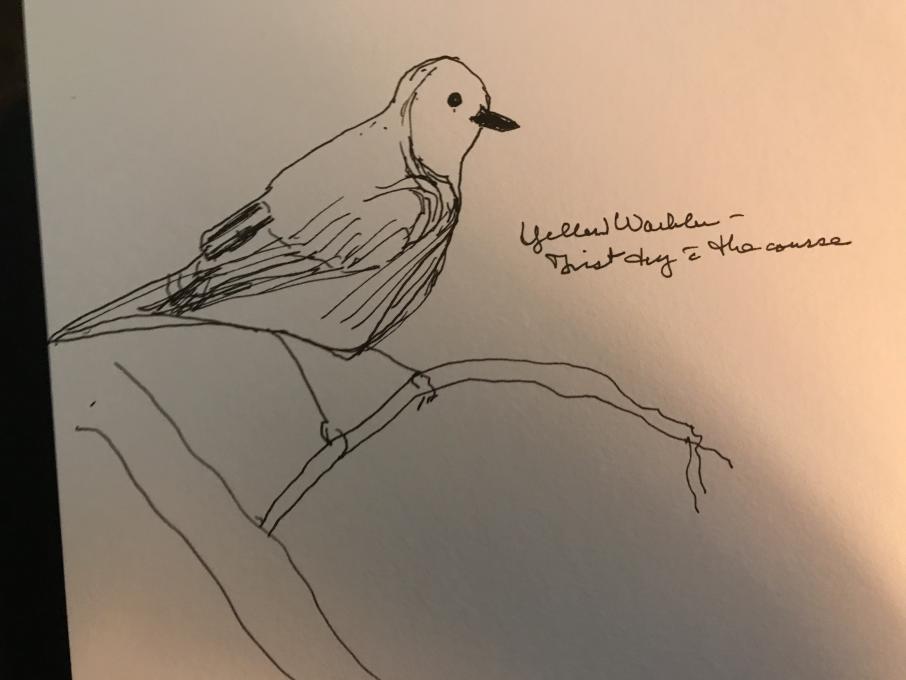
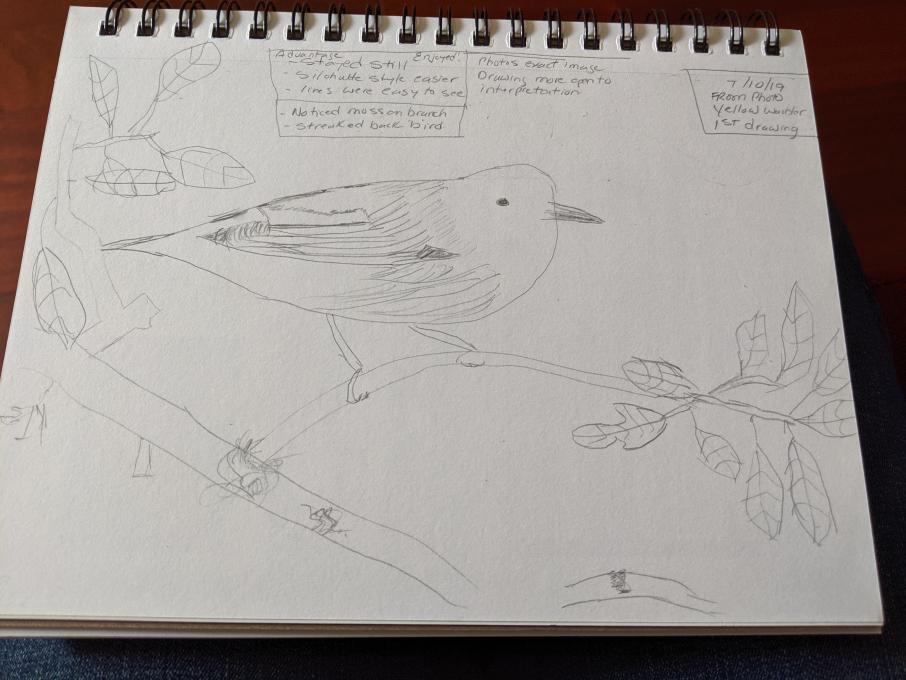
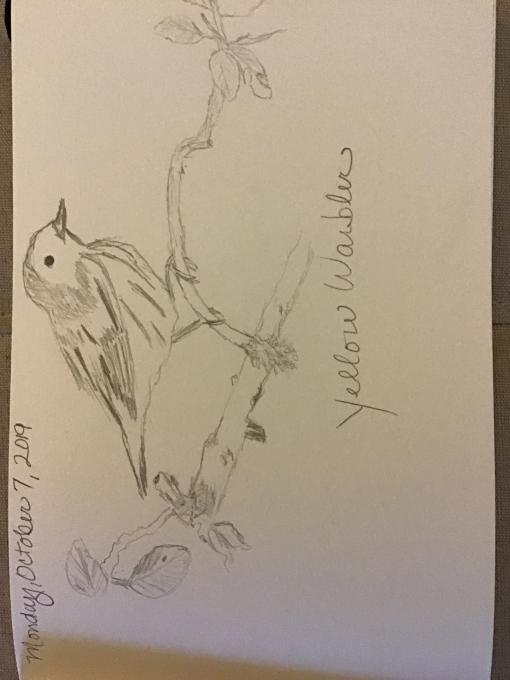
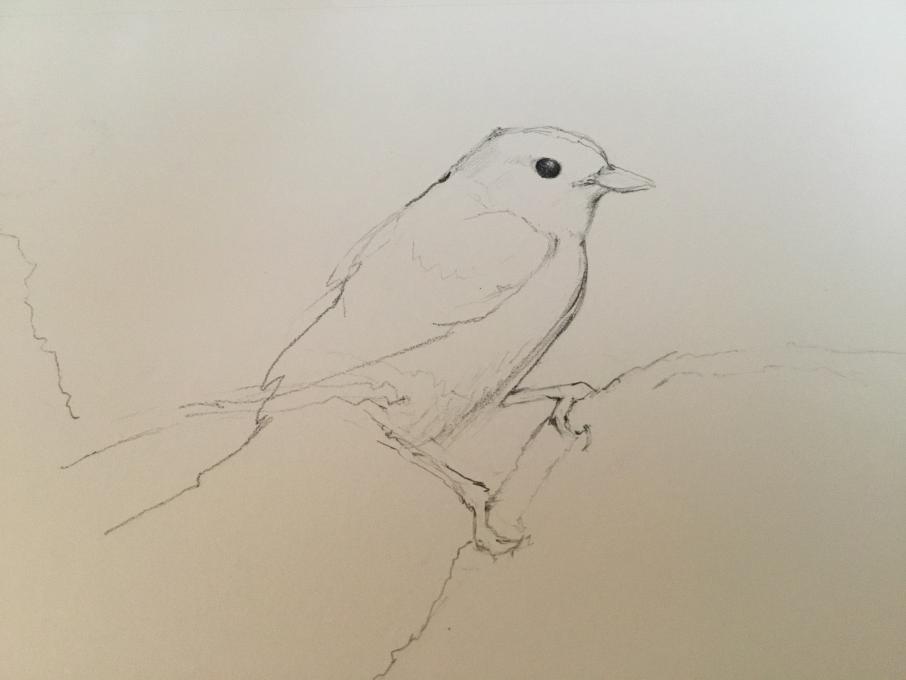 Drawing from a photo allows you more time to see and render what you might have missed in a quicker sketch or gesture drawing; however, it can also slow down the drawing process causing one to get hung up on little details or how to represent those details more (photo)realistically, if that makes sense. It provides one with a static image that you can continuously refer back to. Drawing from life forces you to move quickly and keep going with the process...of observing and creating what you see in front of you, at that moment, instead of what you think something should look like.
Studying the photo gave me the opportunity to look more closely at the shapes, sizes and colors of lichens and mosses pictured on the branch. But it also afforded me more time to see how the bird was framed by the leaves on both sides of the shot and how the color of the warbler is also picked up in the mosses. Although I didn't capture those details in this drawing, I could go back and add them at a later date, which makes it very convenient. One doesn't really have that opportunity in nature. But with practice, these key details could be included or "suggested" through skillful use of line and color. Now, I can see how using watecolor allows you to capture the "essence" of nature or a scene without stressing about absolute precision.
Drawing from a photo allows you more time to see and render what you might have missed in a quicker sketch or gesture drawing; however, it can also slow down the drawing process causing one to get hung up on little details or how to represent those details more (photo)realistically, if that makes sense. It provides one with a static image that you can continuously refer back to. Drawing from life forces you to move quickly and keep going with the process...of observing and creating what you see in front of you, at that moment, instead of what you think something should look like.
Studying the photo gave me the opportunity to look more closely at the shapes, sizes and colors of lichens and mosses pictured on the branch. But it also afforded me more time to see how the bird was framed by the leaves on both sides of the shot and how the color of the warbler is also picked up in the mosses. Although I didn't capture those details in this drawing, I could go back and add them at a later date, which makes it very convenient. One doesn't really have that opportunity in nature. But with practice, these key details could be included or "suggested" through skillful use of line and color. Now, I can see how using watecolor allows you to capture the "essence" of nature or a scene without stressing about absolute precision. 
 1. I haven't done much drawing from photos, and it felt a little strange. It is very nice having a model that isn't constantly moving, though! Drawing from the photo made it easier to get overall proportions and the angles of the beak and feet correct--although I definitely didn't get things quite right. It is always a challenge for me to not try to get things exactly right, and to be okay when they aren't (and they usually aren't). I have to keep reminding myself that nature journaling isn't about creating art. It's about recording observations, which I already know how to do, in a format I'm not familiar with and using skills I don't yet have.
2. Drawing always makes me notice things I wouldn't otherwise see. That's why I have all of my students do some drawing. In this example I paid close attention to the angles of the wing feathers. Not that you can tell from my drawing!
1. I haven't done much drawing from photos, and it felt a little strange. It is very nice having a model that isn't constantly moving, though! Drawing from the photo made it easier to get overall proportions and the angles of the beak and feet correct--although I definitely didn't get things quite right. It is always a challenge for me to not try to get things exactly right, and to be okay when they aren't (and they usually aren't). I have to keep reminding myself that nature journaling isn't about creating art. It's about recording observations, which I already know how to do, in a format I'm not familiar with and using skills I don't yet have.
2. Drawing always makes me notice things I wouldn't otherwise see. That's why I have all of my students do some drawing. In this example I paid close attention to the angles of the wing feathers. Not that you can tell from my drawing!  I told myself not to stress about this, and just went to do a quick sketch to get going. I hope to see improvement as I go along!
Getting the feathers right was difficult! However, it was a fun way to get started.
I told myself not to stress about this, and just went to do a quick sketch to get going. I hope to see improvement as I go along!
Getting the feathers right was difficult! However, it was a fun way to get started. 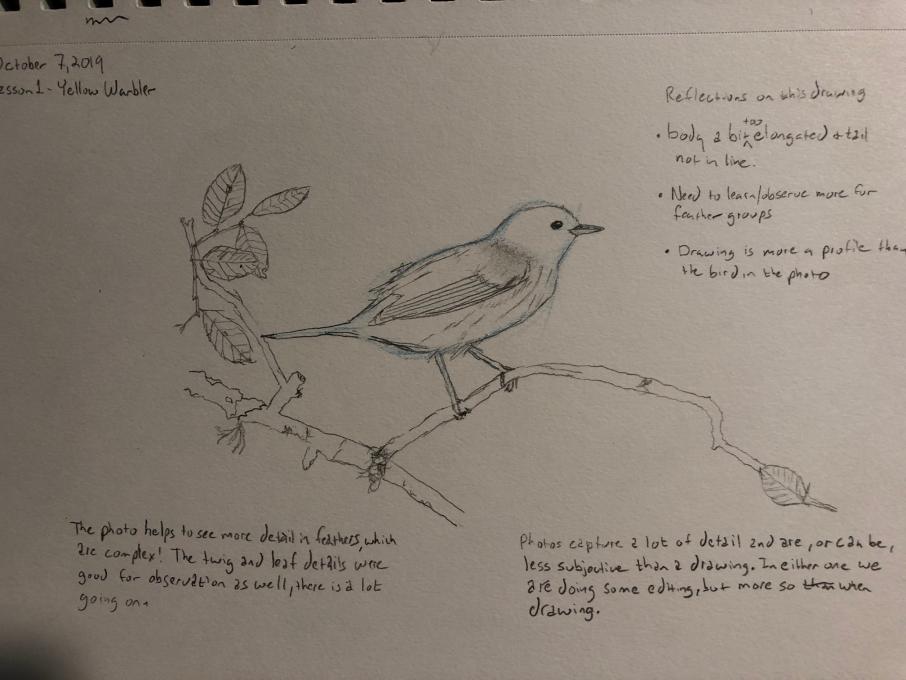
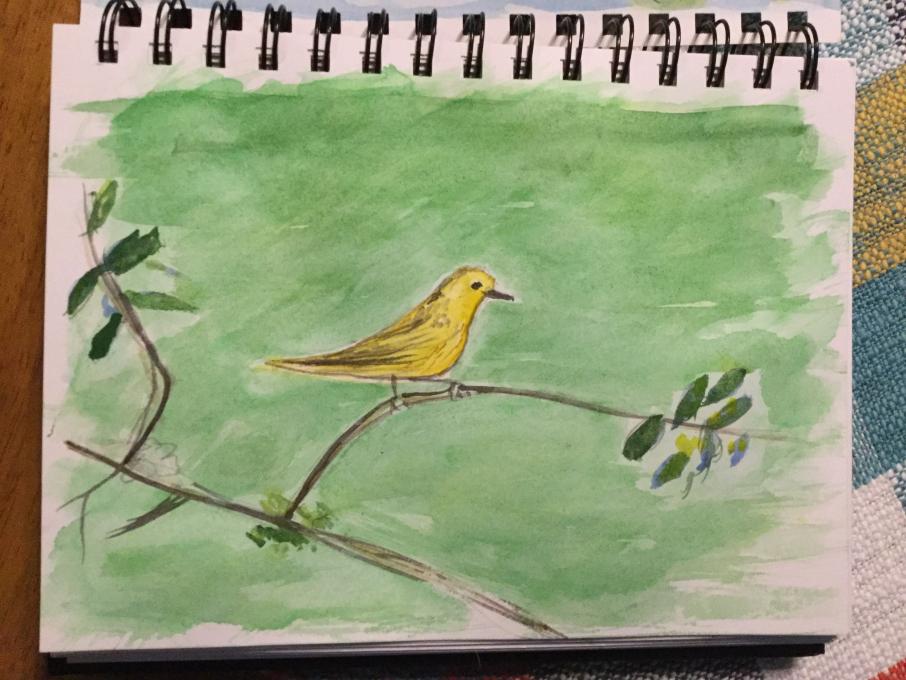
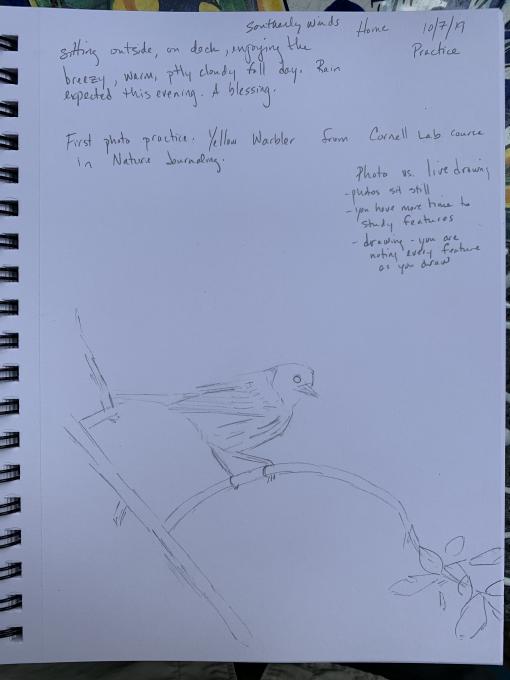 Okay...so I had to get brave enough to post that. I’m definitely in sketch phase, and I stopped on purpose. I drew the branch first so I could proportion the tail and bird in conjunction with the side branches and curve. I love reading the other responses as I -kinda- noticed lichens, but my full focus was on bird and proportioning.
As noted, photos sit still, making it easy to notice the details. The advantage I noted to drawing is that I’m paying more attention to those same details, and out in the field, this will help in bird id, as I can easily gloss over tail length and primary projection and eye line beginning and endings, and with some species (*coughPhiladelphia Vireocough*), this is critical information.
As an aside, it would be cool to know how many people are signed up taking the course. I’m very excited about it and am looking forward to sharing and improving!
Okay...so I had to get brave enough to post that. I’m definitely in sketch phase, and I stopped on purpose. I drew the branch first so I could proportion the tail and bird in conjunction with the side branches and curve. I love reading the other responses as I -kinda- noticed lichens, but my full focus was on bird and proportioning.
As noted, photos sit still, making it easy to notice the details. The advantage I noted to drawing is that I’m paying more attention to those same details, and out in the field, this will help in bird id, as I can easily gloss over tail length and primary projection and eye line beginning and endings, and with some species (*coughPhiladelphia Vireocough*), this is critical information.
As an aside, it would be cool to know how many people are signed up taking the course. I’m very excited about it and am looking forward to sharing and improving! 
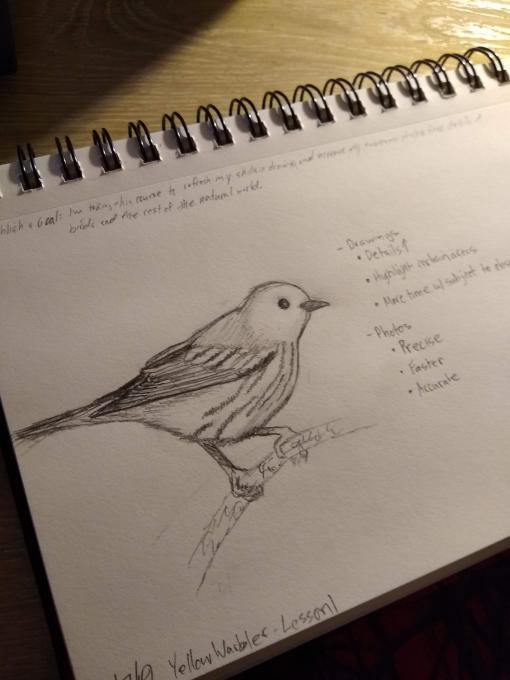 1. Drawing from photos was how I originally got into drawing when I was younger. I would sit for hours looking at books about dinosaurs and draw my favorites. This exercise reminded me of that. The shape of the bird seemed to come more easily to me than the finer details of the feathers, shadows, and legs.
2. Something I began to notice as I got to the wings was that I was counting the feathers trying to get more details on the primaries. I don't sit around counting the feathers on the photos I take, so I found that I was learning something about the bird because I wanted to be more accurate in my drawing.
1. Drawing from photos was how I originally got into drawing when I was younger. I would sit for hours looking at books about dinosaurs and draw my favorites. This exercise reminded me of that. The shape of the bird seemed to come more easily to me than the finer details of the feathers, shadows, and legs.
2. Something I began to notice as I got to the wings was that I was counting the feathers trying to get more details on the primaries. I don't sit around counting the feathers on the photos I take, so I found that I was learning something about the bird because I wanted to be more accurate in my drawing. 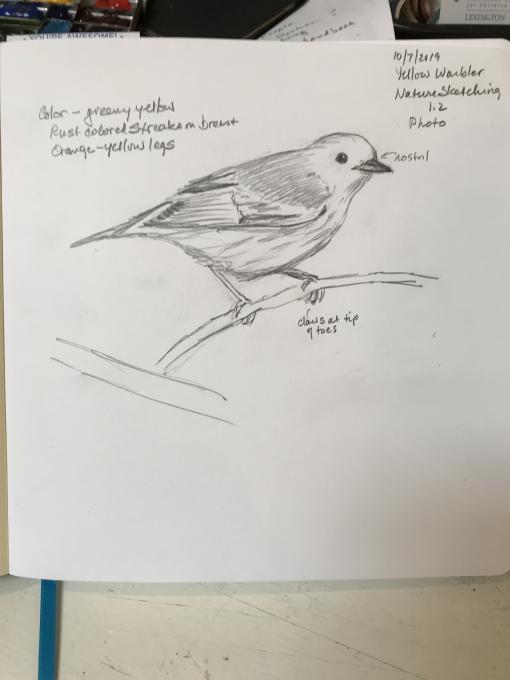 I agree with Mike - the bird stood still in the photo so it was easier to see the details. On the other hand, my drawing feels static - I felt no sense of the live animal. Perhaps I would have felt differently had I been drawing from my own photo.
By drawing from a photo, it was easier to see the negative spaces around the bird and get the overall shape from that. This would be harder to see from a wild bird, I would think.
I agree with Mike - the bird stood still in the photo so it was easier to see the details. On the other hand, my drawing feels static - I felt no sense of the live animal. Perhaps I would have felt differently had I been drawing from my own photo.
By drawing from a photo, it was easier to see the negative spaces around the bird and get the overall shape from that. This would be harder to see from a wild bird, I would think.